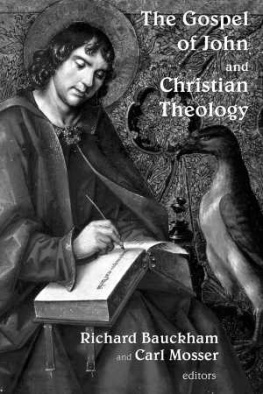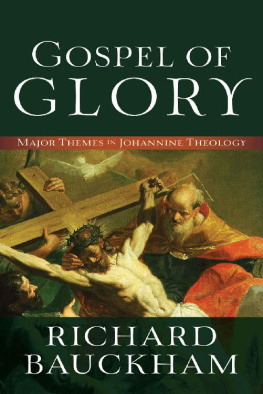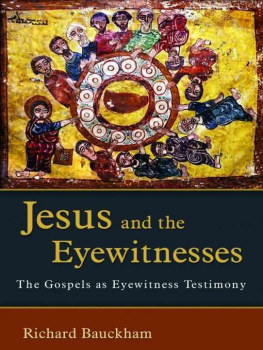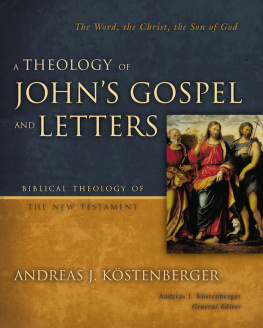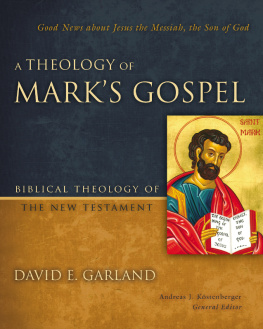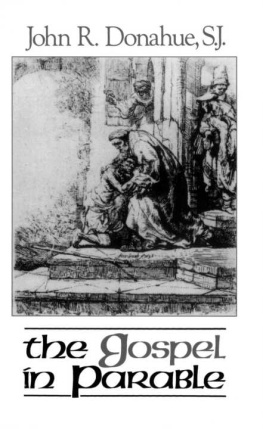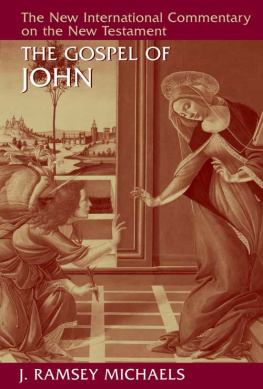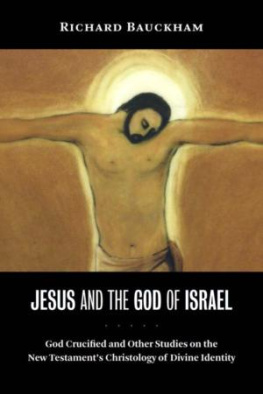Richard Bauckham - The Testimony of the Beloved Disciple: Narrative, History, and Theology in the Gospel of John
Here you can read online Richard Bauckham - The Testimony of the Beloved Disciple: Narrative, History, and Theology in the Gospel of John full text of the book (entire story) in english for free. Download pdf and epub, get meaning, cover and reviews about this ebook. year: 2007, publisher: Baker Publishing Group, genre: Religion. Description of the work, (preface) as well as reviews are available. Best literature library LitArk.com created for fans of good reading and offers a wide selection of genres:
Romance novel
Science fiction
Adventure
Detective
Science
History
Home and family
Prose
Art
Politics
Computer
Non-fiction
Religion
Business
Children
Humor
Choose a favorite category and find really read worthwhile books. Enjoy immersion in the world of imagination, feel the emotions of the characters or learn something new for yourself, make an fascinating discovery.
- Book:The Testimony of the Beloved Disciple: Narrative, History, and Theology in the Gospel of John
- Author:
- Publisher:Baker Publishing Group
- Genre:
- Year:2007
- Rating:3 / 5
- Favourites:Add to favourites
- Your mark:
- 60
- 1
- 2
- 3
- 4
- 5
The Testimony of the Beloved Disciple: Narrative, History, and Theology in the Gospel of John: summary, description and annotation
We offer to read an annotation, description, summary or preface (depends on what the author of the book "The Testimony of the Beloved Disciple: Narrative, History, and Theology in the Gospel of John" wrote himself). If you haven't found the necessary information about the book — write in the comments, we will try to find it.
Richard Bauckham: author's other books
Who wrote The Testimony of the Beloved Disciple: Narrative, History, and Theology in the Gospel of John? Find out the surname, the name of the author of the book and a list of all author's works by series.
The Testimony of the Beloved Disciple: Narrative, History, and Theology in the Gospel of John — read online for free the complete book (whole text) full work
Below is the text of the book, divided by pages. System saving the place of the last page read, allows you to conveniently read the book "The Testimony of the Beloved Disciple: Narrative, History, and Theology in the Gospel of John" online for free, without having to search again every time where you left off. Put a bookmark, and you can go to the page where you finished reading at any time.
Font size:
Interval:
Bookmark:

2007 by Richard Bauckham
Published by Baker Academic
a division of Baker Publishing Group
P.O. Box 6287, Grand Rapids, MI 49516-6287
www.bakeracademic.com
Ebook edition created 2014
All rights reserved. No part of this publication may be reproduced, stored in a retrieval system, or transmitted in any form or by any meansfor example, electronic, photocopy, recordingwithout the prior written permission of the publisher. The only exception is brief quotations in printed reviews.
ISBN 978-1-4412-0079-2
Library of Congress Cataloging-in-Publication Data is on file at the Library of Congress, Washington, DC.
To Martin Hengel
with gratitude
for his immense contribution
to New Testament research
C ONTENTS
I NTRODUCTION
The essays collected in this volume cover a wide variety of aspects of the study of the Gospel of John, but they cohere within an approach to the Gospel that differs very significantly from the approach that has been dominant in Johannine scholarship since the late 1970s, though there are signs that this dominant approach is now being undermined or at least considerably modified by very recent trends in Johannine scholarship. The purpose of this introductory chapter is to relate my essays in this volume to current and recent Johannine scholarship, and also to explain their relationships and coherence within the alternative approach to John that they exemplify.
The Dominant Approach
In the last three decades of the twentieth century, but, to say the least, the dominant approach could not be ignored by any Johannine scholar. The main elements of the dominant approach are:
1. Little if any credit is given to the traditions of the early church about the origins and authorship of the Gospel, since they are held to be incompatible with the internal evidence of the Gospel itself. The external evidence is assumed to attribute the Gospel to the apostle John the son of Zebedee, but the dominant approach, though it usually presumes that the figure of the Beloved Disciple in the Gospel is based on a historical figure who played a part in the history of the Gospels community and traditions, considers the Beloved Disciple neither John the son of Zebedee nor the author of the Gospel. The early Christian traditions location of the Gospels origin in Ephesus is usually thought to be merely a corollary of the erroneous attribution of the Gospel to John the son of Zebedee. For most exponents of the dominant approach the community behind the Gospel was far too marginal a Christian group to be located in a city such as Ephesus, with its well-known Christian community, associated with Paul, and its position at the hub of many channels of communications.
2. As an account of the history of Jesus this Gospel is far less reliable than the Synoptics, since its traditions have been so thoroughly shaped by the history of the highly distinctive Christian community in which they evolved. The dominant approach takes up the much older (nineteenth-century) scholarly judgment that this Gospel is theology rather than history, but gives it a much more sociohistorical or sociological character. The dominant approach, since it generally regards this Gospel as independent of the Synoptics, is actually more ready than its nineteenth-century precursors to admit that the Gospel may preserve genuinely historical traditions about Jesus that are not to be found in the Synoptics. They would seem, however, to have been preserved in spite of, rather than because of, the character of this Gospel.
3. The Gospel of John is the product of a complex history of literary composition which has left the marks of its various stages on the text as we have it, making it possible to reconstruct its literary prehistory. This confidence in source criticism as a key to understanding the Gospel has Bultmanns commentary as its most influential forebear, even though Bultmanns specific theories have not survived well. In the face of more synchronic, literary-critical approaches to reading the Gospel, the dominant approach continues to appeal to the well-known aporias, the repetitions and incoherences in the literary sequence of the text, as well as to the inconsistencies in its ideology, that require diachronic explanation.
4. The Gospel is the product of and written for the so-called Johannine community, a small and idiosyncratic branch of early Christianity, sectarian in character, isolated from the rest of the early Christian movement, and formed by its own particular history and conflicts. This aspect of the dominant approach corresponds to the importance given in the same period to the community of each Gospel (understood as both the context of origin and the audience of that Gospel) in study of the Synoptic Gospels. But for several reasons, including the existence of the Johannine letters, reconstruction of the Johannine community has flourished even more than those of the Matthean, Markan, and Lukan communities.
5. Elements 3 and 4 coalesce in that the various stages of the composition of the Gospel are held to reflect developments in the history of the Johannine community. In the dominant approach, the reconstructed history of the text and the reconstructed history of the community are inseparable. This is where the dominant approach of the last three decades of the twentieth century differs from the older (and numerous) theories of multiple sources, authors and redactions. Such theories go back to the nineteenth century, but only from the late 1960s have they been closely connected with the notion of a special Johannine community and the reconstruction of its history.
6. The reconstruction of the history of the community is partly based on the so-called two-level reading of the Gospel narrative, which assumes that the Gospels story of Jesus is also to be understood as the story of the Johannine community. The parade example, with which J. Louis Martyn initiated the enterprise of reconstructing the communitys history from the Gospel, is the story of the healing of the blind man in chapter 9. Here Jesus stands for a Christian prophet in the communitys present, the blind man is a Christian convert, and the Jews are the authorities of the synagogue to which the Johannine community had belonged until it had been expelled, like the blind man in the story. That the traumatic event in the communitys history that accounts for much of the character of the Gospel as we have it was expulsion from its local synagogue is concluded from this episode in the Gospel (along with 16:2). Similarly the story of Jesus in Samaria in chapter 4 reflects an earlier stage in the communitys history that included successful mission to Samaritans.
7. Reconstructions of the history of the Johannine community are many and diverse, but there is broad agreement that this history focuses on the communitys relationship to the Jewish matrix in which it arose and from which it later painfully separated. The character of the Gospel is intimately related to the origin of the community within the synagogue, its attempts to persuade other members of the synagogue of the messiahship of Jesus, its expulsion from the synagogue and its increasingly bitter and polemical attitude to the parent body from which it had separated. On most accounts, the background, context and membership of the Johannine community are Jewish, though Gentiles play a minor part in some reconstructions. In this respect, the dominant approach is indebted to the effect the publication of the Dead Sea Scrolls had in highlighting the Jewishness of the Fourth Gospel in place of the Hellenistic character regularly attributed to it in most earlier scholarship.
Something Completely Different
Next pageFont size:
Interval:
Bookmark:
Similar books «The Testimony of the Beloved Disciple: Narrative, History, and Theology in the Gospel of John»
Look at similar books to The Testimony of the Beloved Disciple: Narrative, History, and Theology in the Gospel of John. We have selected literature similar in name and meaning in the hope of providing readers with more options to find new, interesting, not yet read works.
Discussion, reviews of the book The Testimony of the Beloved Disciple: Narrative, History, and Theology in the Gospel of John and just readers' own opinions. Leave your comments, write what you think about the work, its meaning or the main characters. Specify what exactly you liked and what you didn't like, and why you think so.


